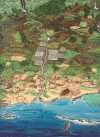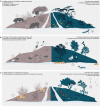Harnessing island-ocean connections to maximize marine benefits of island conservation
- PMID: 36508667
- PMCID: PMC9907155
- DOI: 10.1073/pnas.2122354119
Harnessing island-ocean connections to maximize marine benefits of island conservation
Abstract
Islands support unique plants, animals, and human societies found nowhere else on the Earth. Local and global stressors threaten the persistence of island ecosystems, with invasive species being among the most damaging, yet solvable, stressors. While the threat of invasive terrestrial mammals on island flora and fauna is well recognized, recent studies have begun to illustrate their extended and destructive impacts on adjacent marine environments. Eradication of invasive mammals and restoration of native biota are promising tools to address both island and ocean management goals. The magnitude of the marine benefits of island restoration, however, is unlikely to be consistent across the globe. We propose a list of six environmental characteristics most likely to affect the strength of land-sea linkages: precipitation, elevation, vegetation cover, soil hydrology, oceanographic productivity, and wave energy. Global databases allow for the calculation of comparable metrics describing each environmental character across islands. Such metrics can be used today to evaluate relative potential for coupled land-sea conservation efforts and, with sustained investment in monitoring on land and sea, can be used in the future to refine science-based planning tools for integrated land-sea management. As conservation practitioners work to address the effects of climate change, ocean stressors, and biodiversity crises, it is essential that we maximize returns from our management investments. Linking efforts on land, including eradication of island invasive mammals, with marine restoration and protection should offer multiplied benefits to achieve concurrent global conservation goals.
Keywords: invasive mammals; island management; land–sea linkage.
Conflict of interest statement
The authors declare no competing interest.
Figures



References
-
- Waterhouse J., Brodie J., Lewis S., Audas D.-M., Land-sea connectivity, ecohydrology and holistic management of the Great Barrier Reef and its catchments: Time for a change. Ecohydrol. Hydrobiol. 16, 45–57 (2016).
-
- Ruttenberg B. I., Granek E. F., Bridging the marine–terrestrial disconnect to improve marine coastal zone science and management. Mar. Ecol. Prog. Ser. 434, 203–212 (2011).
-
- Menge B. A., et al. , Terrestrial ecologists ignore aquatic literature: Asymmetry in citation breadth in ecological publications and implications for generality and progress in ecology. J. Exp. Mar. Biol. Ecol. 377, 93–100 (2009).
-
- Di Marco M., et al. , Changing trends and persisting biases in three decades of conservation science. Glob. Ecol. Conserv. 10, 32–42 (2017).
Publication types
MeSH terms
LinkOut - more resources
Full Text Sources
Research Materials

